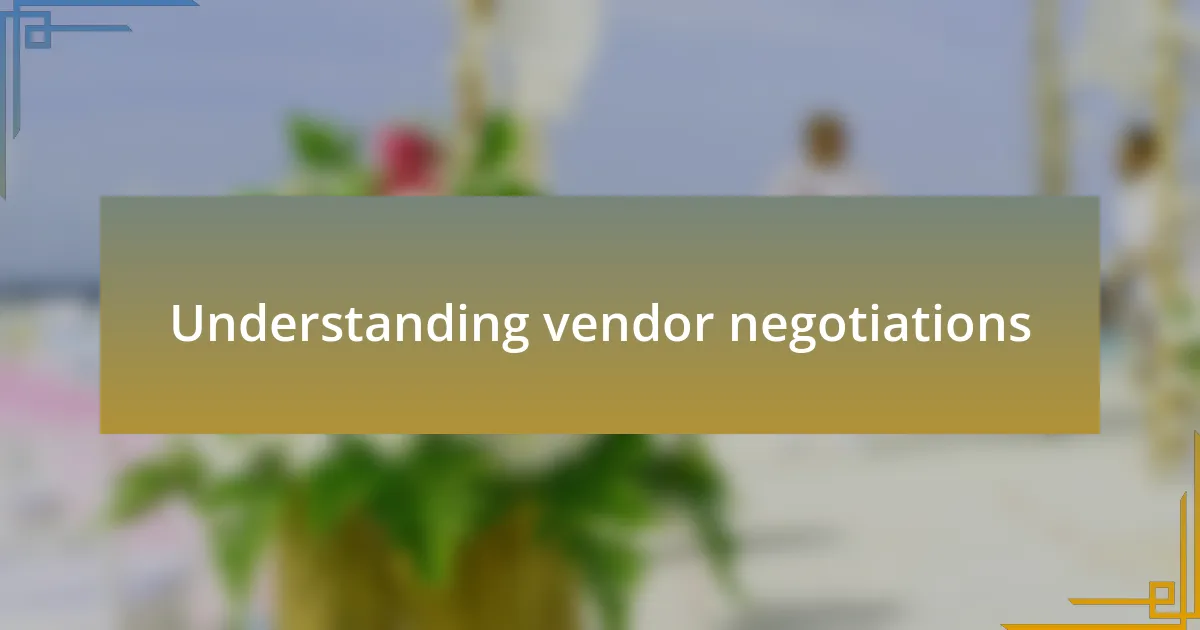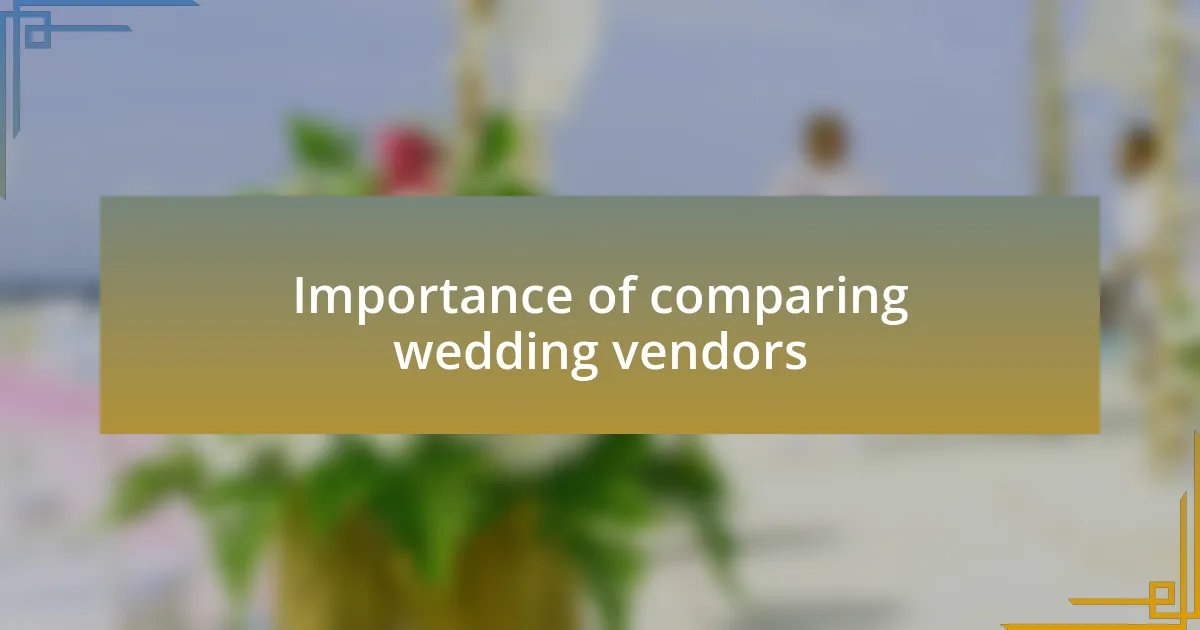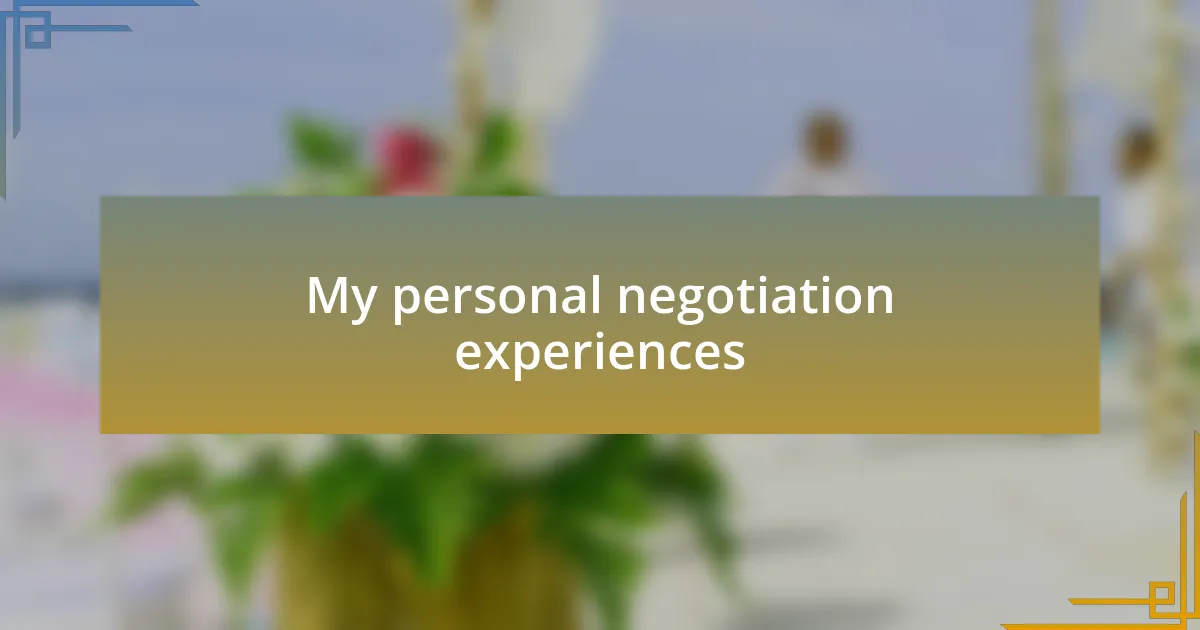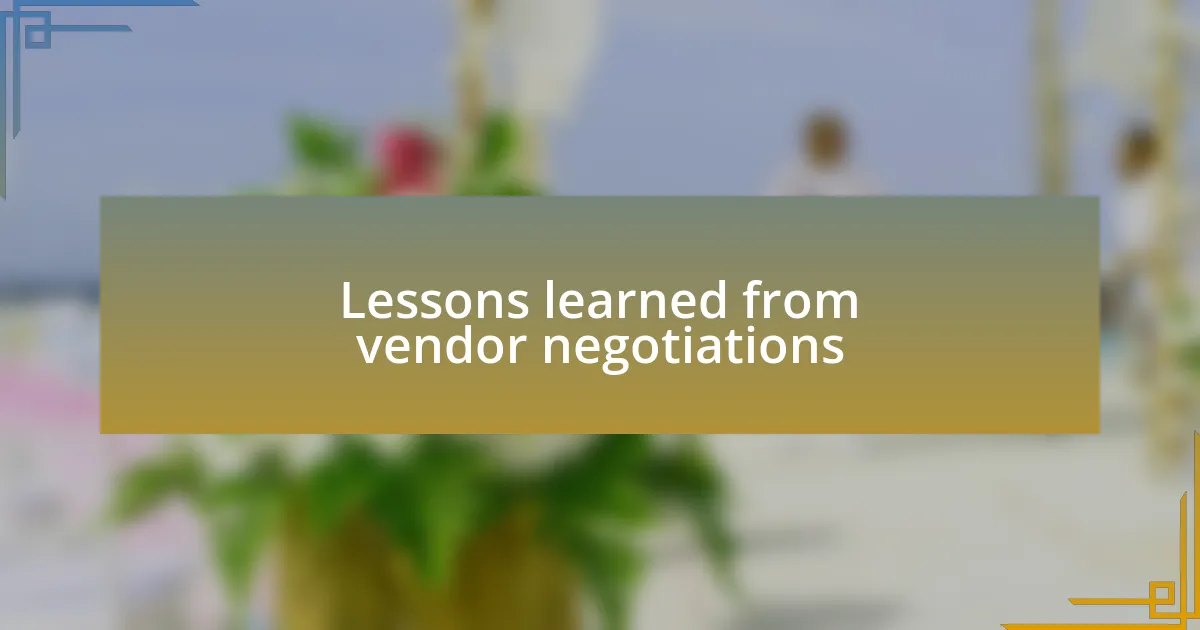Key takeaways:
- Preparation and adaptability are vital in vendor negotiations; researching competitors enhances confidence and helps articulate budget needs.
- Emotional insights and personal connections can foster rapport, often leading to creative solutions from vendors.
- Comparing vendors involves more than price-checking; understanding hidden costs and aligning services with personal vision is crucial.
- Active listening and collaboration can significantly improve negotiation outcomes, creating stronger bonds and better proposals.

Understanding vendor negotiations
Vendor negotiations can feel overwhelming, especially in the wedding planning process where emotions run high. I remember feeling a mix of excitement and anxiety as I reached out to different vendors. It was crucial for me to grasp their pricing structures and what each service included, leading me to ask, “What truly sets your services apart?”
Understanding the art of negotiation involves both preparation and adaptability. I found that researching competitor rates not only armed me with confidence but also allowed me to articulate my budget restrictions clearly. There were moments when I wondered, “Am I asking too much?” but I soon realized that a respectful conversation can open doors to better offers and creative solutions.
Emotional insights play a vital role in these discussions. When negotiating with my florist, I shared how important their work was to my vision. This personal touch not only enhanced our rapport but also made them more willing to find ways to accommodate my budget. It taught me that negotiation isn’t just about numbers; it’s a dance of understanding needs and building relationships.

Importance of comparing wedding vendors
When planning my wedding, I quickly learned that comparing vendors was more than just price-checking; it was about finding the right fit for my needs. One experience that stands out is when I encountered two photographers with drastically different styles. I asked myself, “Which one captures the essence of my vision?” Evaluating their portfolios not only clarified my aesthetic preferences but also helped me understand what each would bring to my special day.
Another crucial takeaway for me was recognizing the hidden costs that can sneak into vendor pricing. I vividly recall discussing cake options with one vendor who offered a lower base price but charged extra for each custom flavor. I found myself pondering, “Is this really the best deal?” By comparing multiple quotes and services, I was able to avoid unexpected budget blowouts, reinforcing the importance of thorough research in my decision-making process.
In the end, the value of comparing vendors became crystal clear: it empowered me to make informed choices. I learned that asking the right questions could unveil services that truly aligned with my vision. For instance, when I shared my excitement about a specific theme with one florist, they proposed creative solutions that exceeded my expectations. It wasn’t just about cost; it was about connecting with vendors who genuinely understood my dreams.

Strategies for approaching multiple vendors
When approaching multiple vendors, I found that developing a clear communication strategy was essential. I meticulously compiled a list of questions that addressed not only pricing but also availability and service specifics. Don’t you want to know if they would cater to your unique vision? This preparation allowed me to engage confidently and extract the information I needed to make sound decisions.
I also discovered the importance of personal connections. During my outreach, I made a conscious effort to express my enthusiasm for each vendor’s work. I remember one florist who lit up when I mentioned my dream of a whimsical garden theme. That instant rapport made me feel more comfortable negotiating and ultimately led to some surprising and generous offerings.
Another effective strategy was to leverage competition. I’d share that I was considering multiple options when discussing services. This approach often prompted vendors to enhance their proposals, whether through better pricing or added perks. It’s fascinating how a simple mention of alternatives can shift their perspective.

My personal negotiation experiences
When I think about my experiences negotiating with multiple vendors, I remember the challenge of balancing assertiveness with kindness. I once spoke with a caterer who seemed hesitant about my budget. Instead of pushing, I shared my vision for a memorable dining experience, hoping to find common ground. It was rewarding to see how this conversation opened up avenues for creative solutions, blending affordability with my dream menu.
I learned that honesty can be a powerful tool in negotiations. There was a moment when I had to walk away from a vendor because the numbers simply didn’t align. I communicated my reasons transparently, and to my surprise, the vendor reached out later with a revised offer that reflected my budget constraints. This taught me the value of genuine dialogue; you never know what might happen when you’re upfront about your needs.
Another memorable negotiation involved a photography package where I felt my ideal vision was at risk due to the cost. I shared my enthusiasm for their portfolio but expressed concern over the budget. Building that personal connection paid off, as they crafted a tailored package for me, which included a special mini-session without additional charges. It was a reminder that sometimes, being direct yet passionate can resonate deeply with vendors, leading to unexpected compromises.

Lessons learned from vendor negotiations
Negotiating with vendors taught me the importance of flexibility. I vividly recall a situation with a florist who offered a stunning design but at a price that sent shivers down my spine. Instead of fixating on the initial quote, I openly discussed my budget but also expressed what elements of their work drew me in. This approach led us to explore innovative alternatives, and it felt like we were both co-creators in making my vision a reality rather than just haggling over prices.
One critical lesson I learned was the power of preparation. Before meeting with a baker, I gathered a comprehensive list of my requirements and examples of styles I loved. This preparation gave me the confidence to articulate my needs clearly, and it sparked a fascinating conversation about customizing my cake flavor and design. It made me realize that being equipped with knowledge not only helps negotiate better terms but also fosters a collaborative relationship with the vendor.
In reflecting on these experiences, I found that sometimes negotiating involves more than just facts—emotions play a significant role. There was a time I needed to adjust my wedding planner’s services as they weren’t aligning with my expectations. I decided to share my concerns, not just as a client but as someone genuinely invested in the outcome. This honesty led to a candid discussion that ultimately strengthened our working relationship and resulted in solutions that truly met my needs. It’s moments like these that remind me that empathy and understanding are invaluable during negotiations.

Tips for successful negotiation outcomes
I found that approaching negotiations with a mindset of collaboration rather than confrontation can significantly enhance the outcome. For instance, I vividly remember chat sessions with a caterer who seemed hesitant to accommodate my dietary needs. By framing the conversation around how I wanted to ensure all guests enjoyed the meal, we successfully crafted a menu that was both delightful and inclusive. Have you ever experienced a situation where a simple shift in perspective changed the tone of a discussion?
Another tip that profoundly shaped my negotiation experience was active listening. During a discussion with a photographer, I noticed that when I paused and truly listened to her suggestions, we unlocked a shared vision that exceeded my expectations. It was a bit like putting together a puzzle—each piece revealed more of the overall picture. This approach not only demonstrated respect for her expertise but also fostered a stronger bond, making her more willing to accommodate my requests.
Additionally, I learned the value of timing in negotiations. There was a moment when I decided to inquire about additional services right after the vendor presented their initial quote. By being attentive to the flow of our conversation, I was able to seize that opportune moment. This timing allowed me to leverage their enthusiasm for the project while discussing potential add-ons, which ultimately benefitted both sides. Have you found that the moment you choose to ask can change the entire dynamic of a conversation? It’s an insightful reminder of the nuances that can make negotiations successful.